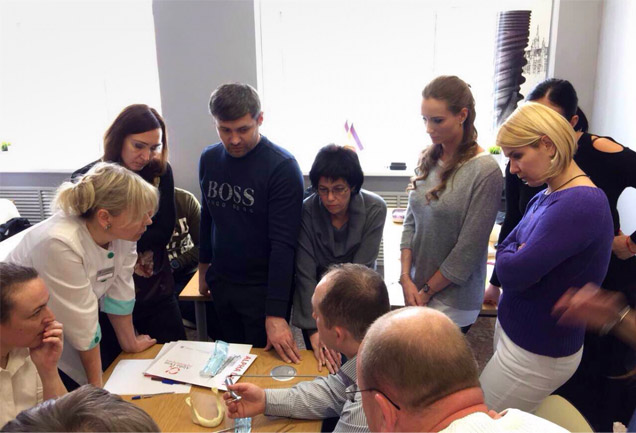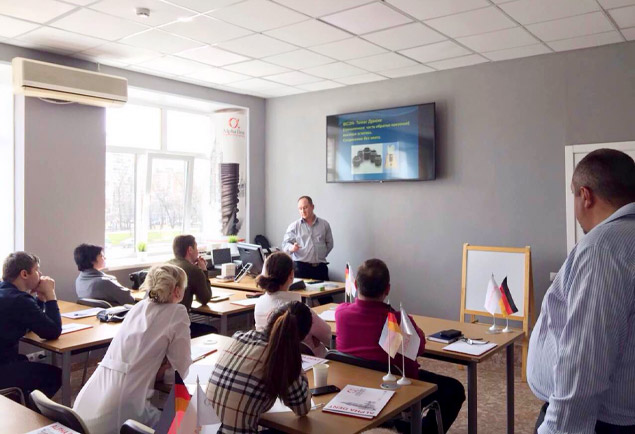Level 1: Basic. “The main stages of implantation”
In a programme:
1. History
2. Implantation is one of the methods. Goals, objectives, opportunities.
3. Indications and contraindications. Absolute and relative.
4. The importance of planning. Surgeon, orthopedist, patient – who is the team captain?
5. Bone: anatomy, physiology. Blood supply and innervation of hard and soft tissues in the area of planned implantation. Types and types of bone tissue.
6. Varieties of implants and their characteristics. Materials, implant geometry, macro- and microdesign of the surface, implant-abutment connection.
7. Osseointegration – what is meant by this?
Bone remodeling. Dates and ways to achieve the objectives.
8. The choice of implant to solve the existing clinical problem. The optimal implant placement site, spatial orientation, angles, distances, and depth.
9. The choice of surgical protocol. Flapless technique. Immediate insertion of a tooth replacement into the socket of the removed tooth. Terms, tools, sequence.
10. Pharmacology. What, when, and how much?
11. Complications.
12. The formation of the gums. Materials, arguments, timelines, and algorithms.
13. Receiving a print. open and closed spoon. Search from the implant level and the abutment level.
14. Fixation of orthopedic construction. Screw or cement? Fixing removable structures.
15. Control of occlusal contacts. Overload value for implant life.
In a programme:
1. History
2. Implantation is one of the methods. Goals, objectives, opportunities.
3. Indications and contraindications. Absolute and relative.
4. The importance of planning. Surgeon, orthopedist, patient – who is the team captain?
5. Bone: anatomy, physiology. Blood supply and innervation of hard and soft tissues in the area of planned implantation. Types of bone tissue.
6. Varieties of implants and their characteristics. Materials, implant geometry, macro- and microdesign of the surface, and implant-abutment connection.
7. Osseointegration – what is meant by this?
Bone remodeling. Dates and ways to achieve the objectives.
8. The choice of implant to solve the existing clinical problem. The optimal implant placement site, spatial orientation, angles, distances, and depth.
9. The choice of surgical protocol. Flapless technique. Immediate insertion of a tooth replacement into the socket of the removed tooth. Terms, tools, sequence.
10. Pharmacology. What, when, and how much?
11. Complications.
12. The formation of the gums. Materials, arguments, timelines and algorithms.
13. Receiving a print. open and closed spoon. Search from the implant level and the abutment level.
14. Fixation of orthopedic construction. Screw or cement? Fixing removable structures.
15. Control of occlusal contacts. Overload value for implant life.
In a programme:
1. History
2. Implantation is one of the methods. Goals, objectives, opportunities.
3. Indications and contraindications. Absolute and relative.
4. The importance of planning. Surgeon, orthopedist, patient – who is the team captain?
5. Bone: anatomy, physiology. Blood supply and innervation of hard and soft tissues in the area of planned implantation. Types of bone tissue.
6. Varieties of implants and their characteristics. Materials, implant geometry, macro- and microdesign of the surface, and implant-abutment connection.
7. Osseointegration – what is meant by this?
Bone remodeling. Dates and ways to achieve the objectives.
8. The choice of implant to solve the existing clinical problem. The optimal implant placement site, spatial orientation, angles, distances, and depth.
9. The choice of surgical protocol. Flapless technique. Immediate insertion of a tooth replacement into the socket of the removed tooth. Terms, tools, sequence.
10. Pharmacology. What, when and how much?
11. Complications.
12. The formation of the gums. Materials, arguments, timelines, and algorithms.
13. Receiving a print. open and closed spoon. Search from the implant level and the abutment level.
14. Fixation of orthopedic construction. Screw or cement? Fixing removable structures.
15. Control of occlusal contacts. Overload value for implant life.
In a programme:
1. History
2. Implantation is one of the methods. Goals, objectives, opportunities.
3. Indications and contraindications. Absolute and relative.
4. The importance of planning. Surgeon, orthopedist, patient – who is the team captain?
5. Bone: anatomy, physiology. Blood supply and innervation of hard and soft tissues in the area of planned implantation. Types and types of bone tissue.
6. Varieties of implants and their characteristics. Materials, implant geometry, macro- and microdesign of the surface, implant-abutment connection.
7. Osseointegration – what is meant by this?
Bone remodeling. Dates and ways to achieve the objectives.
8. The choice of implant to solve the existing clinical problem. The optimal implant placement site, spatial orientation, angles, distances, and depth.
9. The choice of surgical protocol. Flapless technique. Immediate insertion of a tooth replacement into the socket of the removed tooth. Terms, tools, sequence.
10. Pharmacology. What, when, and how much?
11. Complications.
12. The formation of the gums. Materials, arguments, timelines, and algorithms.
13. Receiving a print. open and closed spoon. Search from the implant level and the abutment level.
14. Fixation of orthopedic construction. Screw or cement? Fixing removable structures.
15. Control of occlusal contacts. Overload value for implant life.
In a programme:
1. History
2. Implantation is one of the methods. Goals, objectives, opportunities.
3. Indications and contraindications. Absolute and relative.
4. The importance of planning. Surgeon, orthopedist, patient – who is the team captain?
5. Bone: anatomy, physiology. Blood supply and innervation of hard and soft tissues in the area of planned implantation. Types of bone tissue.
6. Varieties of implants and their characteristics. Materials, implant geometry, macro- and microdesign of the surface, and implant-abutment connection.
7. Osseointegration – what is meant by this?
Bone remodeling. Dates and ways to achieve the objectives.
8. The choice of implant to solve the existing clinical problem. The optimal implant placement site, spatial orientation, angles, distances, and depth.
9. The choice of surgical protocol. Flapless technique. Immediate insertion of a tooth replacement into the socket of the removed tooth. Terms, tools, sequence.
10. Pharmacology. What, when and how much?
11. Complications.
12. The formation of the gums. Materials, arguments, timelines, and algorithms.
13. Receiving a print. open and closed spoon. Search from the implant level and the abutment level.
14. Fixation of orthopedic construction. Screw or cement? Fixing removable structures.
15. Control of occlusal contacts. Overload value for implant life.


Most recently, training was organized by Alpha Dent Implants for dentists who are just starting to get acquainted with dental implantology. ;The presentation was held by the leading master, implant dentist Vladimir Anatolyevich Korobtsev, maxillofacial surgeon, orthopedic dentist, head physician of the dent-el clinic network.